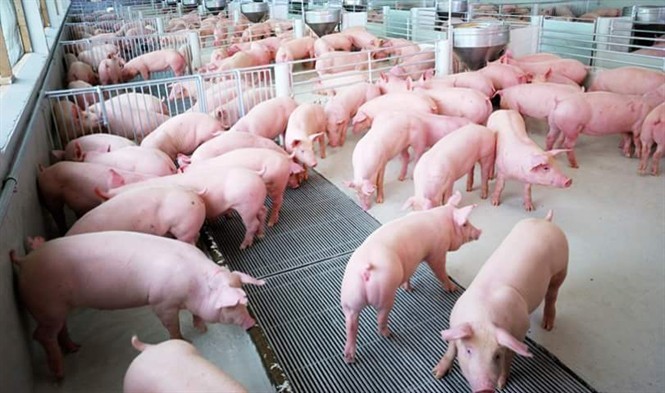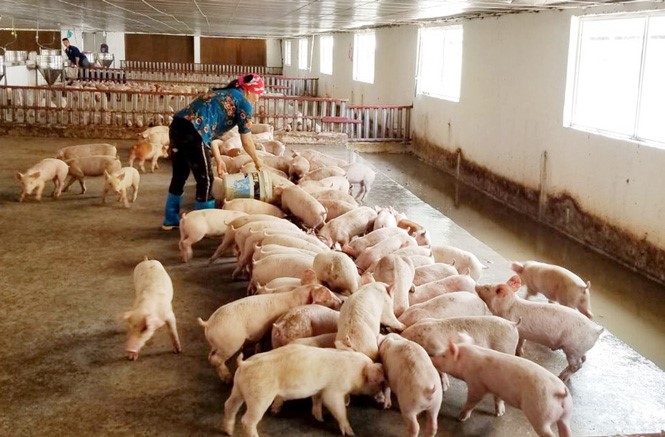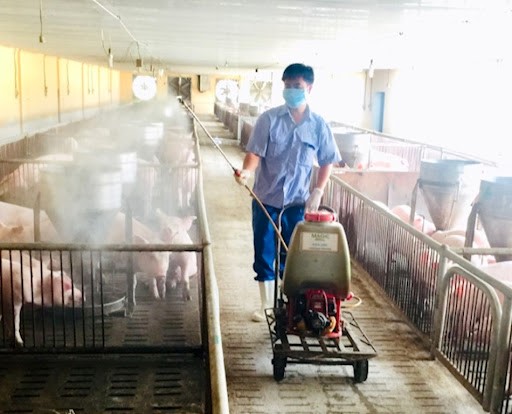In the process of raising animals, the outbreak of epidemics is inevitable. Farmers need to master safe and effective management and disease prevention measures for pigs, as well as prevent and minimize damage.
Pig farming has recently received great advantages from market prices, pig prices are always high. However, the pig farming industry is also facing huge obstacles due to losses caused by epidemics such as African Swine Fever, blue ear, pneumonia, etc. Therefore, effective disease management and prevention in pigs has become more urgent.
It can be said that hygiene is the basis and foundation of disease prevention measures in livestock farming. When the living environment is unfavorable, animals will have reduced resistance and will be susceptible to pathogens such as bacteria, viruses and parasites, creating epidemics.
To prevent diseases, in addition to creating a good living environment, reducing factors that cause disadvantages to animals, and improving the resistance and immunity of animals, farmers also need to minimize exposure to pathogens in livestock will thereby limit the spread of the disease. Good feeding care and disease prevention are the most important factors that help farmers reduce economic losses caused by epidemics.

Image of pigs
Diseases can spread in many different ways. When farmers understand the contagious nature of each type of pathogen, they will be more proactive in cleaning and preventing epidemics. Cleaning and disinfecting are effective solutions to control epidemics.
In pig farming, farmers need to pay attention to implementing some specific hygiene and management measures as follows:
1/ Hygiene measures:
– Leave the cage empty after each farming session to help break the cycle of disease spread. Leaving the cage empty for 3 to 4 weeks or longer will give better results. Leaving the cage empty when combined with cleaning and disinfection such as Belucid and Dexid 400, which will help prevent disease effectively.
– Disinfection pits help prevent the transmission of pathogens from one place to another, from one livestock area to another. Disinfection pits are often placed at the beginning of the barn row or farm gate. Farmers can use Dexon supper at these locations.
– Clean the sows before moving them to the farrowing barn. Clean the sow with soap or a mild antiseptic
– Regularly monitor and observe sick pigs. When a sick pig is detected, it must be isolated. When pigs die due to disease or unknown causes, they must be destroyed or buried deeply.
Image of hygiene measures
2/ Management measures
– Buy healthy pigs from a farm certified with epidemic safety, transport them on a specialized truck that has been thoroughly disinfected, and must be quarantined for 30 to 60 days before entering the farm if safe.
– Restrict and do not allow visitors to visit the barn.
– When entering and leaving the barn, workers must change into protective clothing, wear rubber boots, and go through a disinfection room and disinfection pit before entering.
– Prevent other animals such as dogs, cats, (rodents, birds, etc.) from being allowed in the livestock area.
– Have a plan to periodically deworm and spray pesticides to kill bedbugs, scabies, (skin parasites) for pigs.
– Raise pigs of the same age at appropriate density and comply with the “all in – all out” method to limit the spread of diseases.
Image of pigs
– Use feed with appropriate nutritional ingredients and properly preserved techniques
– Water sources and drinking water must be sufficient, clean, uncontaminated and up to standard. Use a water hose to periodically clean the water system.
– Clean the cage every day and keep it dry and clean. The area around the barn must be regularly cleared. Spray insecticide to kill flies and mosquitoes once a month.
– Periodically spray disinfectant on a weekly basis to disinfect cages, feeding troughs, drinking troughs and other livestock tools such as hoes, shovels, boots, and protective clothing.
– Fully vaccinated against diseases that threaten pigs. Vaccinate against major diseases according to current regulations (African Swine Fever, pasteurellosis, foot-and-mouth disease, etc.), other diseases depending on the epidemiological situation of the area being raised (pseudo-rabies, pneumonia, etc.) and vaccinate accordingly. When using antibiotics, you must comply with regulations on type, dosage, and duration of use.
– Have waste treatment measures such as building Biogas, etc. to avoid causing environmental pollution that affects the health of animals and the community.
Management and raising will increase resistance, avoid stress and reduce the possibility of disease transmission, help with hygiene and protect the health of pigs in order to improve economic efficiency of pig farming.


